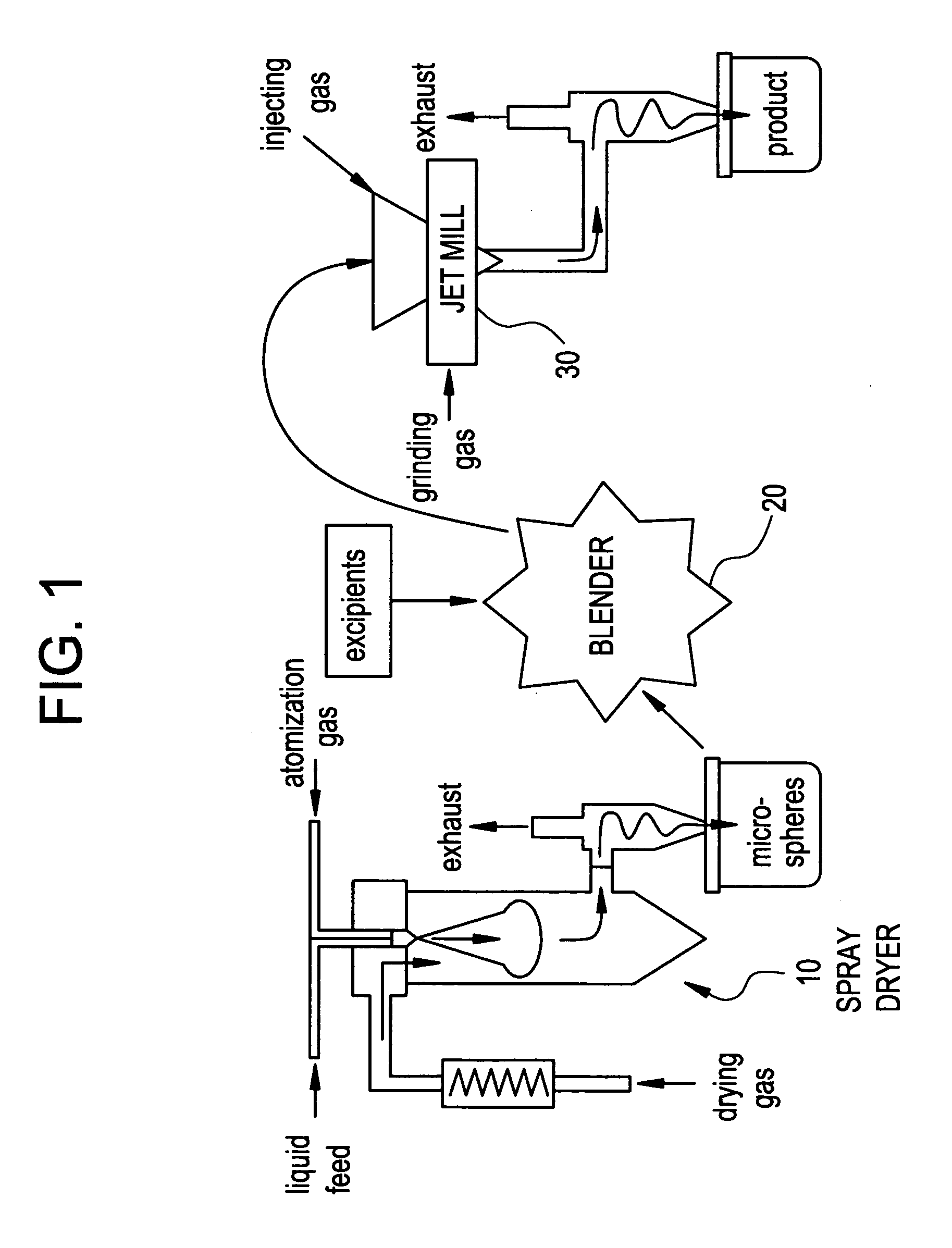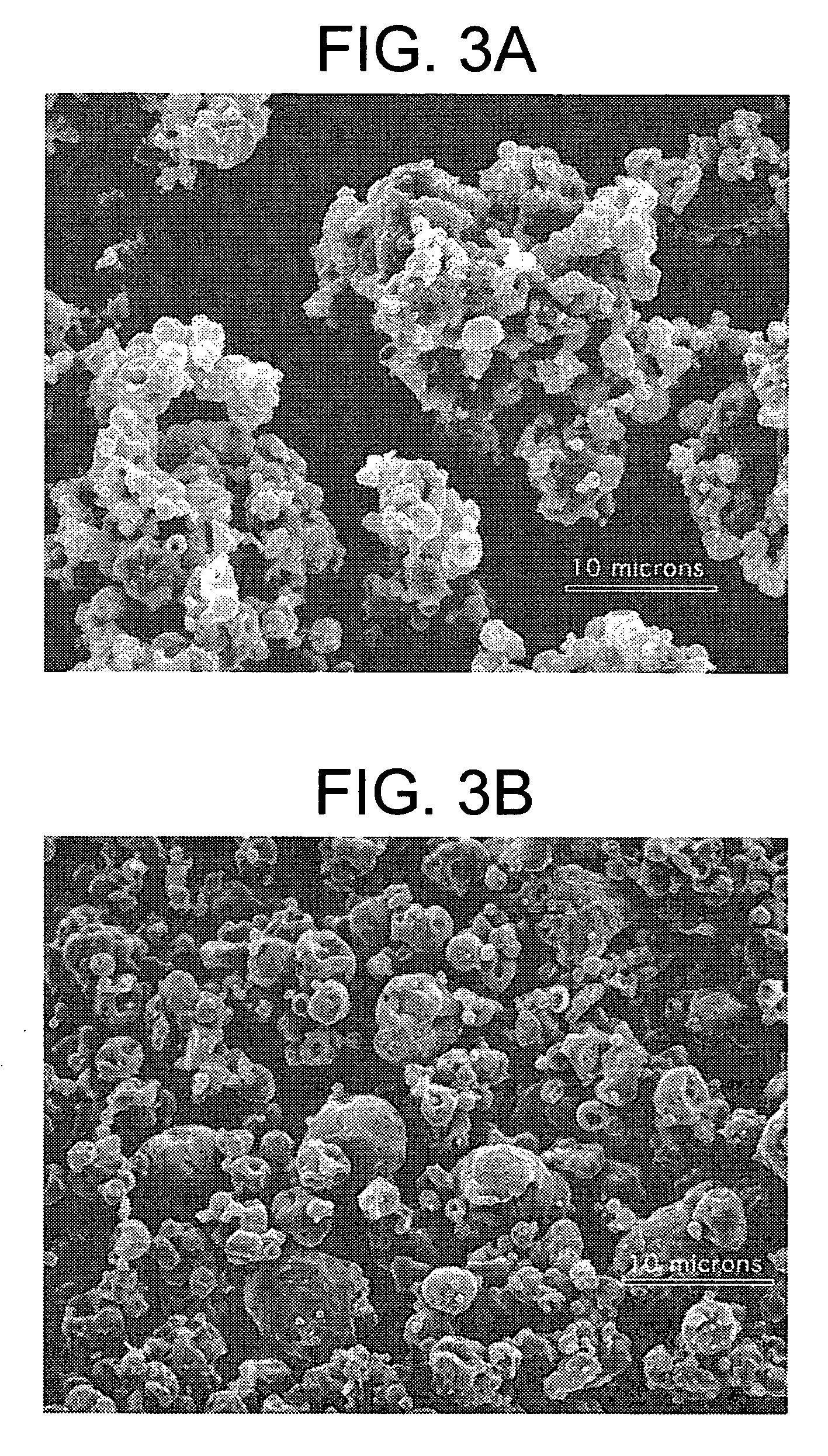Methods for making pharmaceutical formulations comprising deagglomerated microparticles
a technology of microparticles and pharmaceutical formulations, which is applied in the direction of pharmaceutical delivery mechanisms, powder delivery, medical preparations, etc., can solve the problems of detriment to the performance and/or reproducibility of microparticle formulations, microparticles often retain solvent residues, and alter the effective size of particles, so as to improve the suspension of formulations, reduce moisture content and residual solvent levels, and improve aerodynamic properties
- Summary
- Abstract
- Description
- Claims
- Application Information
AI Technical Summary
Benefits of technology
Problems solved by technology
Method used
Image
Examples
example 1
Jet Milling of PLGA Microspheres / Excipient Blend (Made by Dry / Dry Two-Step Blending)
[0120] Blending was conducted in two dry steps. In the first step, 5.46 g of mannitol and 0.16 g of Tween80 were added into a 125 mL glass jar. The jar was then set in the TURBULA™ mixer for 15 minutes at 46 min−1. In the second step, 3.9 g of PLGA microspheres were added into the glass jar containing the blended mannitol and Tween80. The jar was then set in the TURBULA™ mixer for 30 minutes at 46 min−1. A dry blended powder was produced. The dry blended powder was then fed manually into a jet mill for particle deagglomeration. Three sets of operating conditions for the jet mill were used, as described in Table 1.
TABLE 1Jet Mill Operating ConditionsInjector GasGrinding GasSamplePressure (bar)Pressure (bar)1.13.93.01.23.02.91.38.06.6
[0121] The resulting jet milled samples were analyzed for particle size. For comparison, a representative sample of mannitol (pre blending and jet milling), and a contr...
example 2
Jet Milling of PLGA Microspheres / Excipient Blend Made by Wet / Dry Two-Step Blending
[0122] Blending was conducted in two steps: one wet and one dry. In the first step, mannitol and Tween80 were blended in liquid form. A 500 mL quantity of Tween80 / mannitol vehicle was prepared from Tween80, mannitol, and water. The vehicle had concentrations of 0.16% Tween80 and 54.6 mg / mL mannitol. The vehicle was transferred into a 1200 mL Virtis glass jar and then frozen with liquid nitrogen. The vehicle was frozen as a shell around the inside of the jar in 30 minutes, and then subjected to vacuum drying in a Virtis dryer (model: FreezeMobile 8EL) at 31 mTorr for 115 hours. At the end of vacuum drying, the vehicle was in the form of a powder, believed to be the Tween80 homogeneously dispersed with the mannitol. In the second step, 3.9 g of PLGA microspheres were added into the glass jar containing the blended mannitol and Tween80. The jar was then set in the TURBULA™ mixer for 30 minutes at 46 min−...
example 3
Jet Milling of PLGA Microspheres / Excipient Blend Made by One-Step Dry Blending
[0124] In an attempt to reduce the blending time even further, a single blending step was tested. First, 5.46 g of mannitol was added into a 125 mL glass jar. Then 0.16 g of Tween80 and 3.9 g of PLGA microspheres were added into the jar. The jar was then set in the TURBULA™ mixer for 30 minutes at 46 min−1. A dry blended powder was produced. The dry blended powder was fed manually into a jet mill for particle deagglomeration. Three sets of operating conditions for the jet mill were used, as described in Table 5.
TABLE 5Jet Mill Operating ConditionsInjector GasGrinding GasSamplePressure (bar)Pressure (bar)3.13.93.03.23.02.93.38.06.6
[0125] The resulting jet milled samples were analyzed for particle size. For comparison, a control sample (blended but not jet milled) was similarly analyzed. The Coulter Multisizer II values are shown in Table 6.
TABLE 6Results of Particle Size AnalysisNumber Avg.Volume Avg.S...
PUM
| Property | Measurement | Unit |
|---|---|---|
| temperature | aaaaa | aaaaa |
| temperature | aaaaa | aaaaa |
| number average size | aaaaa | aaaaa |
Abstract
Description
Claims
Application Information
 Login to View More
Login to View More - R&D
- Intellectual Property
- Life Sciences
- Materials
- Tech Scout
- Unparalleled Data Quality
- Higher Quality Content
- 60% Fewer Hallucinations
Browse by: Latest US Patents, China's latest patents, Technical Efficacy Thesaurus, Application Domain, Technology Topic, Popular Technical Reports.
© 2025 PatSnap. All rights reserved.Legal|Privacy policy|Modern Slavery Act Transparency Statement|Sitemap|About US| Contact US: help@patsnap.com



